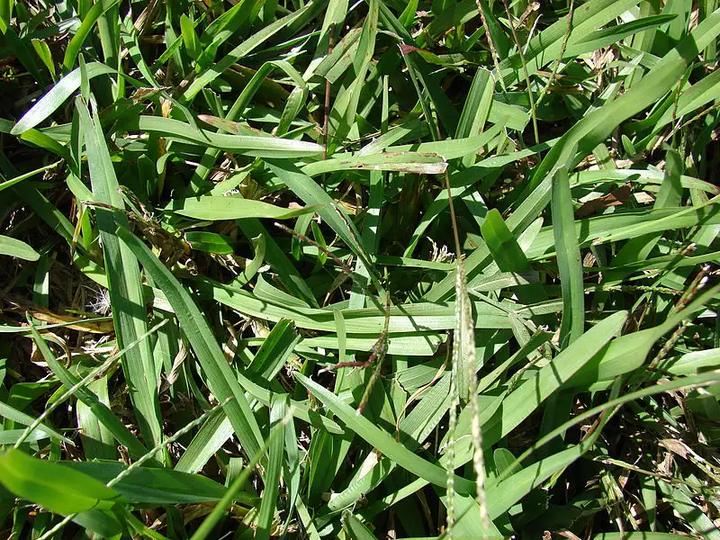Perennial, tough, mat-forming carpetgrasses are often used as lawn coverage in areas where traditional grass won't take.
There are numerous species of carpetgrass, although only two varieties from the Axonopus genus are commonly used for landscaping purposes.
Broadleaf carpetgrass (Axonopus compressus) is a robust tropical species that grows well in hot, humid, wet and shady areas. It's very fast-spreading and is considered to be a weedy, invasive species in many areas.
Narrowleaf carpetgrass (Axonopus fissifolius) is generally considered a more favorable, attractive choice for use in temperate home garden landscapes. This species was previously known as Axonopus affinis before being renamed. It's not uncommon to still see it being referred to by its old botanical name. Our focus in this article will be on narrowleaf carpet grass.
Although carpetgrasses don't produce a lush, thick lawn, they thrive in warm, shady, infertile environments that can be problematic for other grass species.
You'll need to be prepared, however, for them turning brown more easily, looking rather untidy with large seed stalks and heads, and creating a more patchy lawn appearance. Because they're so fast-growing, weekly mowing is recommended during the summer season to keep your garden looking neat.
Narrowleaf carpet grass doesn't spread as aggressively as the broadleaf variety, but it's still prolific. You may have to fence off flower beds and paved areas to prevent the lawn encroaching on these spaces.
Botanical Name:
Axonopus fissifolius (formerly A. affinis)
Common Name:
Carpet grass, Narrowlead carpet grass, blanket grass, common carpet grass
Plant Type:
Creeping perennial grass
Mature Size:
Up to 20 inches (but ideally should be kept considerably shorter)
Sun Exposure:
Partial shade
Soil Type:
Tolerates a variety of moist soils
Soil pH:
Preference for acidic soils
Bloom Time:
June to September
Flower Color:
n/a
Hardiness Zones:
7 to 10
Native Area:
Tropical and Subtropical Americas
How to Grow Carpetgrass
Providing it gets enough moisture and warmth, carpetgrass is low-maintenance. It grows well in shady gardens with infertile soils and on slopes.
Light
Carpetgrass is often selected for areas under thick tree coverage or in other shady positions. It grows well in partial shade and can still cope if it's planted in an area that is in full shade.
Soil
Carpetgrass can cope with a variety of soil pH levels (although it has a preference for acidic types) and is known for still thriving in infertile environments.
It does appreciate loose and moist soil conditions.
Water
Moist but not wet conditions are ideal for carpetgrass. Once the grass is established, it shouldn't require much in the way of watering.
Although more drought-tolerant than the broadleaf variety, the rhizomatous roots of narrowleaf carpetgrass are still shallow and won't penetrate deeply into the soil in search of water. It isn't a species that is suited to regions which experience prolonged dry spells unless you're able to water it regularly.
Carpetgrass doesn't like to be exposed to standing water for prolonged periods either.
Temperature and Humidity
Although narrowleaf carpetgrass is a more frost-tolerant variety than its broadleaf relative, it still won't appreciate freezing conditions and this can result in lawn burn.
It likes humid environments, although it can cope with drier conditions than the broadleaf variety and prefers temperatures between 60 to 80°F for good growth.
Fertilizer
Given its ability to thrive in infertile soils, it shouldn't come as a surprise that carpetgrass doesn't need regular fertilization.
However, if you want new grass to be established as quickly as possible, applying a light application of a balanced fertilizer can help to speed the process up. Some gardeners also apply occasional applications on carpetgrass that is being regularly mown.
Propagating Carpetgrass
Carpetgrass can be propagated readily from the spreading, rhizomatous roots. You just need to dig up the root ball of an established piece of grass and divide it during the warm months.
Make sure all the loose soil is shaken off and that you have removed any damaged roots.
When planting the division, be sure to spread the roots out gently over the soil. There should be at least three or four rhizomes on each piece.
The divisions need to be kept consistently moist until the roots are fully established - this usually occurs within two to three weeks.
Pruning
Regular mowing of your carpetgrass during the warm months has two important advantages.
First, it'll prevent your lawn from developing a disheveled appearance as the seed heads are tall, unsightly and quick to develop.
Secondly, mowing before the seeds have a chance to appear will prevent the grass from spreading to unwanted areas in your garden and beyond.
During the growth season, new seed stalks will spring up as frequently as every five days. This means weekly mowing will be essential if you want to keep things in check.
Carpetgrass can tolerate very close mowing (down to as short as 3/4 of an inch), but if it's kept to a taller height of around 2 inches, this will help produce the healthiest growth.
Growing From Seeds
As you will have discovered by now, growing carpetgrass from seeds isn't tricky.
You should wait until the warmer spring weather arrives. Tilling the soil will help the seeds to take as it'll keep it loose and smooth. After the seeds have been sown, raking can ensure optimal soil coverage.
The soil should be kept consistently moist for a fortnight, and then, for a further two months, weekly watering is recommended.
Once the seedlings are established, unless the season is particularly dry, they should be fine left to spread with little attention.
You Might Like ...